Android 五大布局如下所示:
|
LinearLayout |
线性布局 |
只能指定一个方向(垂直/水平)来布局 |
|
RelativeLayout |
相对布局 |
通过某个控件为参照物,来定位其它控件的位置的布局方式(解决屏幕适配) |
|
TableLayout |
表格布局 |
如果子元素为<TableRow>,则可在一行中放各种控件 |
|
FrameLayout |
帧布局 |
子元素任意 |
|
AbsoluteLayout |
绝对布局 |
通过android:layout_x和android:layout_y来指定元素绝对位置,由于不支持适配,已过时 |
1.如何创建布局
在layout下选择New Android XML File:

然后输入名称,即可完成:
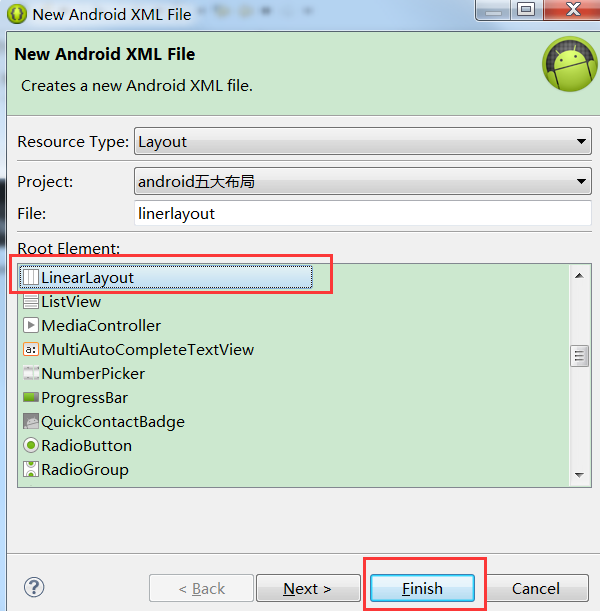
2.LinearLayout线性布局
LinearLayout特有的属性如下所示:
android:orientation= //设置布局方向,填写“horizontal”或者“vertaical”
vertaical方向
xml如下所示:

对应的布局则是垂直向下的,一排只能拥有一个控件:
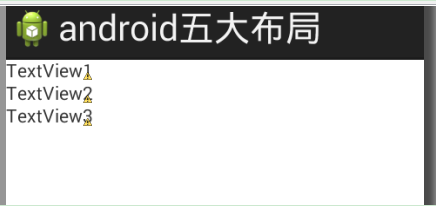
horizontal方向
xml如下所示:

对应的布局则是水平向右的,一列只能拥有一个控件:
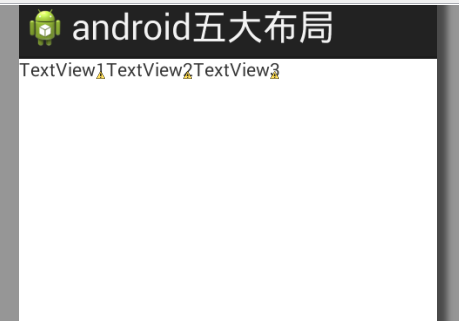
设置控件不同比例
如果要想设置两个控件的比例大小,则设置android:layout_weight(不是android:layout_width),值越大则比例越大(垂直布局则设置高度大小比例,水平布局则设置宽度大小比例)
以垂直线性布局为例,我们设置TextView1占据高度为2倍,其余为1倍
xml设置如下:
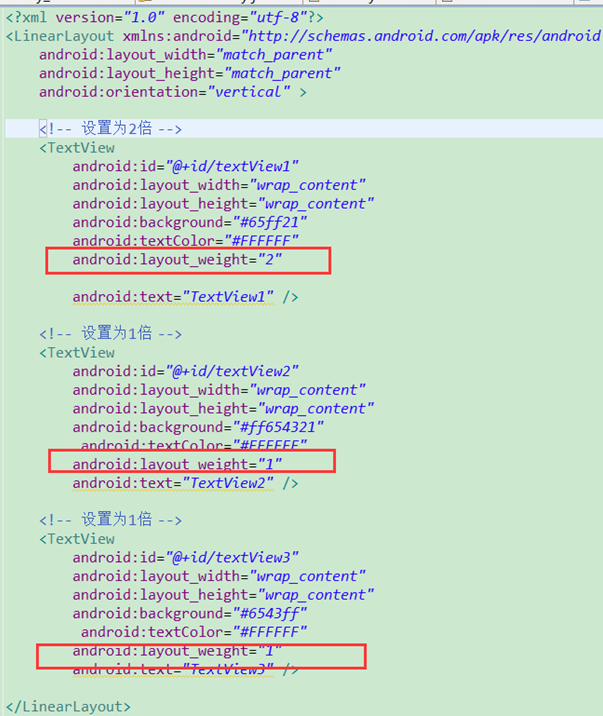
界面如下所示:

PS:在布局中也可以再次添加一个布局.
比如LinearLayout垂直布局中添加一个LinearLayout水平布局,实现登录案例
xml如下:
<LinearLayout xmlns:android="http://schemas.android.com/apk/res/android" xmlns:tools="http://schemas.android.com/tools" android:layout_width="match_parent" android:layout_height="match_parent" android:paddingBottom="@dimen/activity_vertical_margin" android:paddingLeft="@dimen/activity_horizontal_margin" android:paddingRight="@dimen/activity_horizontal_margin" android:paddingTop="@dimen/activity_vertical_margin" android:orientation="vertical" tools:context=".MainActivity" > <EditText android:id="@+id/et_username" android:layout_width="match_parent" android:layout_height="wrap_content" android:hint="请输入用户名" /> <EditText android:id="@+id/et_password" android:layout_width="match_parent" android:layout_height="wrap_content" android:inputType="textPassword" android:hint="请输入密码" /> <!-- 再添加一个水平布局.添加保存信息和登陆button --> <LinearLayout android:layout_width="match_parent" android:layout_height="wrap_content" android:orientation="horizontal"> <CheckBox android:id="@+id/cb_isSave" android:layout_width="0dp" android:layout_height="wrap_content" android:layout_weight="1" android:text="勾选保存信息"/> <Button android:id="@+id/btn_login" android:layout_width="wrap_content" android:layout_height="wrap_content" android:text="登陆" /> </LinearLayout> </LinearLayout>
效果如下:
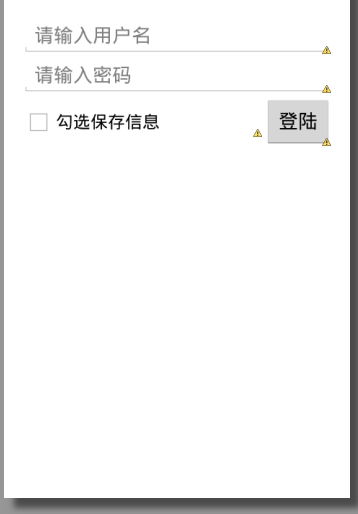
如果只有一个控件设置了android:layout_weight="1",则需要将自身的android:layout_width="0dp",并表示该控件占据剩余的所有空间,如上图的"保存信息"
3.RelativeLayout相对布局
为某一个组件为参照物,来定位下一个组件的位置的布局方式。一般为了解决屏幕分辨率不同的自适应问题(适配神器)
LinearLayout特有的属性如下所示:
|
android:layout_alignParentLeft android:layout_alignParentRight android:layout_alignParentTop android:layout_alignParentBottom |
“true” “false” |
控件在LinearLayout布局中的相对位置 |
|
android:orientation |
“horizontal” “vertaical” |
布局中子控件排布方向 |
|
android:layout_toRightOf android:layout_toLeftOf android:layout_below android:layout_above |
“@+id/***” |
控件和某个控件的位置关系(居右、左、下、上) |
|
android:layout_alignTop android:layout_alignBottom android:layout_alignLeft android:layout_alignRight android:layout_alignBaseline |
“@+id/***” |
控件与其他控件对齐(顶部对齐、底部、左、右对齐、基线(文本内容)对齐) |
|
android:layout_centerHorizontal android:layout_centerVirtical android:layout_centerInParent |
“true” “false” |
指定控件位于水平/垂直/父控件的中间位置 |
如下图所示:
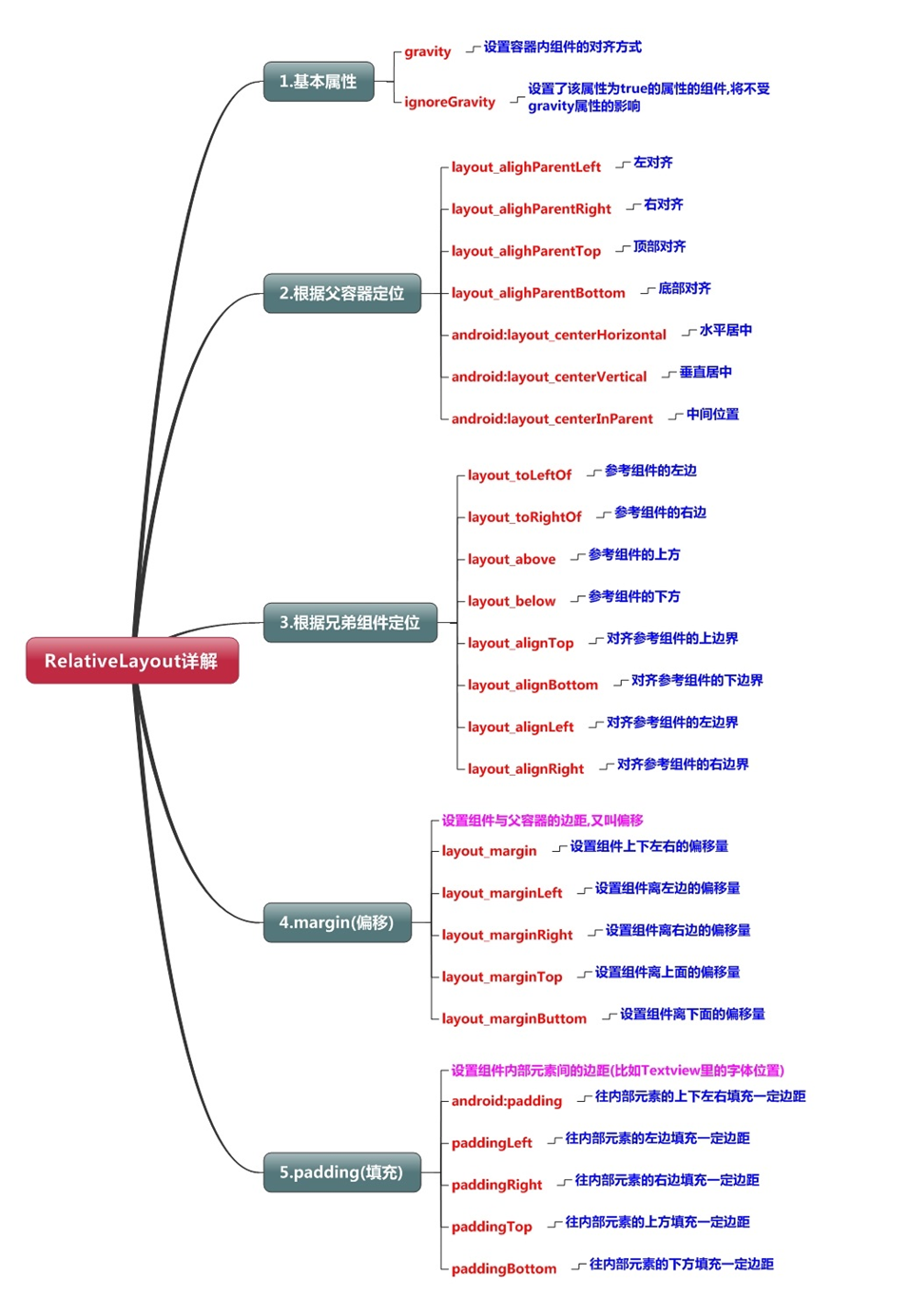
注意:在指定位置关系时,引用的ID必须在引用之前,先被定义,否则将出现异常。
示例-通过RelativeLayout实现固定九宫格(如果要动态实现增删格子,最好还是用GridLayout)
xml如下:
<?xml version="1.0" encoding="utf-8"?> <RelativeLayout xmlns:android="http://schemas.android.com/apk/res/android" android:layout_width="match_parent" android:layout_height="match_parent" > <Button android:id="@+id/button5" android:layout_width="50dp" android:layout_height="50dp" android:layout_centerInParent="true" android:text="5" /> <Button android:id="@+id/button2" android:layout_width="50dp" android:layout_height="50dp" android:layout_centerHorizontal="true" android:layout_above="@id/button5" android:text="2" /> <Button android:id="@+id/button8" android:layout_width="50dp" android:layout_height="50dp" android:layout_centerHorizontal="true" android:layout_below="@id/button5" android:text="8" /> <Button android:id="@+id/button1" android:layout_width="50dp" android:layout_height="50dp" android:layout_alignTop="@id/button2" android:layout_toLeftOf="@id/button2" android:text="1" /> <Button android:id="@+id/button3" android:layout_width="50dp" android:layout_height="50dp" android:layout_alignTop="@id/button2" android:layout_toRightOf="@id/button2" android:text="3" /> <Button android:id="@+id/button4" android:layout_width="50dp" android:layout_height="50dp" android:layout_alignTop="@id/button5" android:layout_toLeftOf="@id/button5" android:text="4" /> <Button android:id="@+id/button6" android:layout_width="50dp" android:layout_height="50dp" android:layout_alignTop="@id/button5" android:layout_toRightOf="@id/button5" android:text="6" /> <Button android:id="@+id/button7" android:layout_width="50dp" android:layout_height="50dp" android:layout_alignTop="@+id/button8" android:layout_toLeftOf="@+id/button8" android:text="7" /> <Button android:id="@+id/button9" android:layout_width="50dp" android:layout_height="50dp" android:layout_alignTop="@+id/button8" android:layout_toRightOf="@+id/button8" android:text="9" /> </RelativeLayout>
布局如下:

4.FrameLayout帧布局
默认所有的控件都是左上对齐(每个控件对应每个界面)。控件可以通过android:layout_gravity属性控制自己在父控件中的位置。
而android:gravity表示:设置文本位置,如设置成”center”,文本将居中显示。
比如下面xml:
<?xml version="1.0" encoding="utf-8"?> <FrameLayout xmlns:android="http://schemas.android.com/apk/res/android" android:layout_width="match_parent" android:layout_height="match_parent" > <TextView android:id="@+id/textView1" android:layout_width="100dp" android:layout_height="50dp" android:textColor="#000000" android:background="#ffFF00" android:text="TextView1" /> <TextView android:id="@+id/textView2" android:layout_width="200dp" android:layout_height="30dp" android:textColor="#000000" android:background="#00FFf0" android:text="TextView2" /> </FrameLayout>
布局如下:
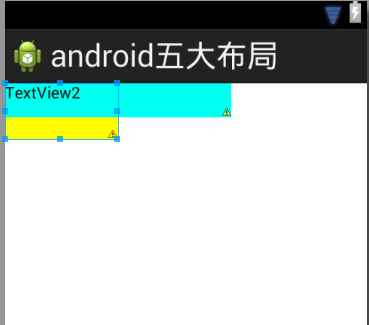
可以看到TextView1已经被覆盖了.
修改textview1,设置为居中:
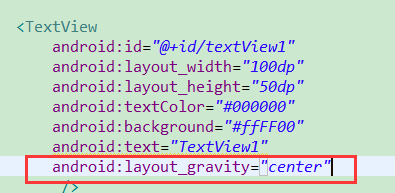
布局效果如下所示:
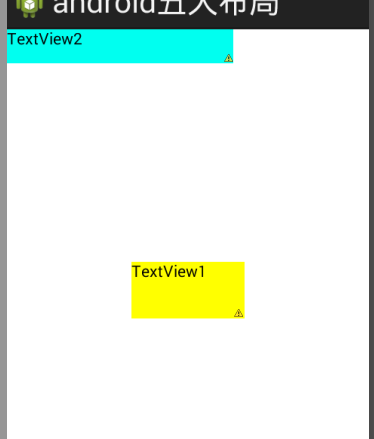
5.TableLayout表格布局
TableLayout特有元素TableRow
通过TableRow可以在一行中放各种控件.
示例如下:
<?xml version="1.0" encoding="utf-8"?> <TableLayout xmlns:android="http://schemas.android.com/apk/res/android" android:layout_width="match_parent" android:layout_height="match_parent" > <TableRow> <TextView android:id="@+id/textView1" android:layout_width="wrap_content" android:layout_height="wrap_content" android:text="TextView1" android:background="#FF0000"/> <TextView android:id="@+id/textView2" android:layout_width="wrap_content" android:layout_height="wrap_content" android:text="TextView2" android:background="#FFF000" /> </TableRow> <TextView android:id="@+id/textView3" android:layout_width="wrap_content" android:layout_height="wrap_content" android:text="TextView3" /> </TableLayout>
布局效果如下:
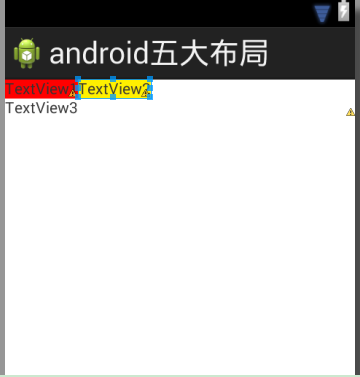
如上图所示,可以看到只有通过TableRow元素包含的控件才能占据为1行.
TableLayout特有属性如下所示:
- android:collapseColumns: 设置需要被隐藏的列的序号
- android:shrinkColumns: 设置允许被收缩的列的列序号
- android:stretchColumns: 设置运行被拉伸的列的列序号
collapseColumns和android:stretchColumns属性示例
<?xml version="1.0" encoding="utf-8"?> <TableLayout xmlns:android="http://schemas.android.com/apk/res/android" android:layout_width="match_parent" android:layout_height="match_parent" android:collapseColumns="1,2" android:stretchColumns="3" > <TableRow> <TextView android:id="@+id/textView1" android:layout_width="wrap_content" android:layout_height="wrap_content" android:text="TextView0" android:background="#FF0000"/> <TextView android:id="@+id/textView2" android:layout_width="wrap_content" android:layout_height="wrap_content" android:text="TextView1" android:background="#FFF000" /> <Button android:id="@+id/button1" android:layout_width="wrap_content" android:layout_height="wrap_content" android:text="2" /> <Button android:id="@+id/button2" android:layout_width="wrap_content" android:layout_height="wrap_content" android:text="3" /> <Button android:id="@+id/button3" android:layout_width="wrap_content" android:layout_height="wrap_content" android:text="4" /> </TableRow> </TableLayout>
布局效果如下:
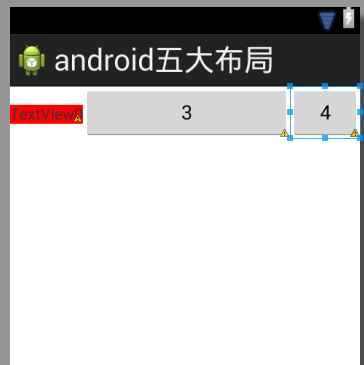
由于设置android:collapseColumns="1,2",所以TextView1和TextView2所在的列被隐藏了.
然后android:stretchColumns="3",由于第一个button位于第3列,所以被拉伸了(列数是从0开始的)
android:shrinkColumns属性示例
<?xml version="1.0" encoding="utf-8"?> <TableLayout xmlns:android="http://schemas.android.com/apk/res/android" android:layout_width="match_parent" android:layout_height="match_parent" android:shrinkColumns="1" > <TableRow> <TextView android:id="@+id/textView1" android:layout_width="wrap_content" android:layout_height="wrap_content" android:text="TextView0" android:background="#FF0000"/> <TextView android:id="@+id/textView2" android:layout_width="wrap_content" android:layout_height="wrap_content" android:text="TextView1" android:background="#FFF000" /> <Button android:id="@+id/button1" android:layout_width="80dp" android:layout_height="wrap_content" android:text="2" /> <Button android:id="@+id/button2" android:layout_width="80dp" android:layout_height="wrap_content" android:text="3" /> <Button android:id="@+id/button3" android:layout_width="80dp" android:layout_height="wrap_content" android:text="4" /> </TableRow> </TableLayout>
布局如下所示:
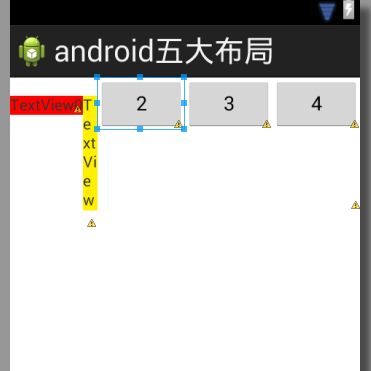
由于android:shrinkColumns="1",所以第二个列支持收缩.
6.AbsoluteLayout绝对布局
已过时, 通过android:layout_x和android:layout_y来指定元素绝对位置,所以不能适配各个不同屏幕大小.
示例如下:
<?xml version="1.0" encoding="utf-8"?> <AbsoluteLayoutxmlns:android="http://schemas.android.com/apk/res/android" android:layout_width="match_parent" android:layout_height="match_parent" > <TextView android:id="@+id/textView1" android:layout_width="wrap_content" android:layout_height="wrap_content" android:layout_x="91dp" android:layout_y="108dp" android:text="TextView" /> <Button android:id="@+id/button1" android:layout_width="wrap_content" android:layout_height="wrap_content" android:layout_x="130dp" android:layout_y="202dp" android:text="Button" /> </AbsoluteLayout>
布局如下:
